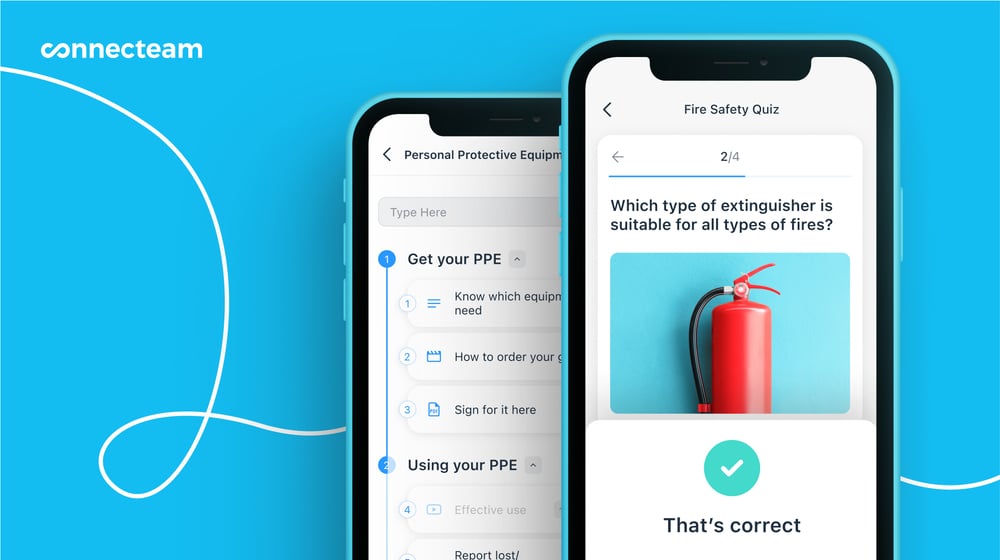Poor-quality employee training can lead to high employee turnover, compliance and legal issues, knowledge gaps, and increased business costs. This article explores the consequences of a lack of training and the benefits of good employee training. We also share tips on how to improve training at your workplace.
Trying to run a successful business without properly training your employees is like swimming against the tide. It’s tiring, frustrating, and ultimately destined for failure.
In today’s dynamic work landscape—where continuous improvement is vital to business success—overlooking the importance of employee training can lead to major consequences. Not only does it affect your workers’ ability to succeed, but it also negatively impacts your company’s efficiency, reputation, and bottom line.
In this guide, we walk you through the consequences of a lack of workplace training and share the benefits of good-quality training. We also offer top tips for conducting training with your team.
The Watercooler EP 10: The Consequences of a Lack of Training in the Workplace
Jessica and Tod explore the consequences of insufficient training in the workplace. Discover how a lack of proper training can impact productivity, employee satisfaction, and business success.
Key Takeaways
- Training in the workplace involves exchanging knowledge and skills to improve employees’ performance, productivity, and more. It can cover various topics and be delivered in person or online.
- Effective training improves business compliance, reduces costly errors, boosts job performance and satisfaction, enhances collaboration, and more.
- The consequences of a lack of training include high employee turnover, compliance issues, safety risks, and increased business costs.
- You can address a lack of workplace training by making training more engaging, accessible, and impactful. Do this by creating SMART training goals, using online training, and considering employees’ learning styles.
What Is Training in the Workplace?
Training in the workplace refers to any employee or manager training that takes place in a work setting. Individuals can complete training one-on-one, on the job, in small groups, or with their entire team.
Workplace training involves sharing knowledge, skills, and competencies to help employees do their jobs more effectively. Most training programs aim to improve workers’ performance, productivity, and efficiency by helping them develop job-specific skills. Training can also help employees learn about workplace policies, understand company software and systems, and enhance their soft skills like communication and collaboration.
Employee training is especially important for new employees during the onboarding process. This ensures they have the information needed to acclimate to the company and success from the get-go.
As a manager, you can deliver training in various ways. You can hold in-person workshops or seminars, hands-on training modules, job shadowing sessions, mentorship schemes, and more. Or, you can go digital and create training materials and videos on e-learning platforms. With digital training, employees can learn on the go—even during downtime at work or out in the field.
The Benefits of Good Employee Training

Improves job performance overall
Training equips employees with the knowledge, skills, and best practices necessary to both excel in their jobs and take on more responsibility. They can grow in confidence, become more efficient and productive, and make better decisions on the job. They’ll spend less time wondering how to complete tasks properly and more time getting work done.
Reduces errors, accidents, and associated costs
Training also gives employees a clear understanding of safety protocols and potential workplace hazards. They’ll know how to avoid endangering themselves and others on job sites, reducing the likelihood of accidents and injuries. In turn, this minimizes costs related to medical treatments following accidents and fixing equipment after it’s been broken.
Similarly, training helps workers avoid making mistakes in general—not just in terms of safety. Workers will understand best practices and the proper operating procedures to follow at your company. They’ll make fewer errors, saving you the cost of fixing them.
Pro Tip
Use a platform like Connecteam that lets you store important company documents, like standard operating procedures and safety training materials, in a digital knowledge base. Employees can access it anytime, from anywhere. This helps further reduce errors and accidents in the workplace.
You might want to explore our guide to the best SOP software to streamline access to standard operating procedures, protocols, and policies, ensuring your team always has essential information at their fingertips.
Get started with Connecteam for free today!
Improves compliance
Likewise, training ensures employees are aware of relevant laws, policies, and regulations that affect their roles and the company as a whole. They’ll know how to stay compliant, helping your business reduce the change of fines, penalties, and regulatory or legal issues.
Enhances adaptability
Effective training can help employees learn new techniques, technologies, and processes. They can more easily stay up to date with industry changes and remain agile in the face of evolving business demands.
Improves customer service skills
Proper employee training gives your team members the skills to provide first-class customer service. Training can teach them to develop empathy, improve their communication skills, and become stronger problem-solvers. These are all key skills in providing customers with a helpful, enjoyable experience. In turn, customers will be more satisfied and more likely to return to your business.
Boosts employee morale, engagement, and satisfaction

Investing in training demonstrates how much you value your employees’ professional development. When employees feel supported through training, they become more engaged and invested in their work. As a result, they typically have higher job satisfaction and are more likely to go above and beyond for your business.
This Might Interest You
Read more about how to measure employee satisfaction and share 6 ways to improve it.
Enhances team cohesion and productivity
Employee training on team-building and communication promotes strong teamwork and collaboration across your business. Your workers can learn to work better as a team and efficiently solve problems together.
When your employees collaborate well, they’re also more productive, which helps you meet deadlines and save money on unnecessary labor costs.
Additionally, teams that work well together have fewer conflicts. This means you can spend less time addressing disagreements and more time on important tasks.
Encourages peer-to-peer learning and a culture of growth
Workplace training fosters peer-to-peer learning, where employees share knowledge and experiences with each other. This helps contribute to a culture of continuous growth and learning across your business.
Consequences of a Lack of Training at Work
A lack of workplace training can lead to various issues that cost your company time, money, and effort—and can even damage your reputation. These include:
High employee turnover
Employees who don’t receive proper training are more likely to feel ill-equipped to succeed in their roles. They may begin to feel discouraged, demotivated, and disengaged. Their overall job satisfaction can drop, causing them to look for job opportunities elsewhere.
And it isn’t just a lack of training that can cause high employee turnover rates. Poor-quality training can also make workers feel unsupported and underappreciated, making them more likely to quit. In fact, studies have shown that 40% of employees would leave their jobs within the first year if not offered the right training.
This Might Interest You
Calculate the real cost of employee turnover at your business by using Connecteam’s turnover cost calculator.
Reduced employee productivity
Without the right training, workers can struggle to do their jobs effectively and may have trouble completing tasks correctly. This leads to decreased productivity as employees spend more time fixing mistakes and getting familiar with proper procedures and less time completing work. Consequently, they’ll be more likely to miss deadlines and have a harder time keeping up with industry and organizational changes.
Safety risks
Proper training is vital to maintaining health and safety within the workplace. Employees who aren’t adequately trained on safety protocols and procedures pose a risk to themselves and their colleagues. They’re more likely to cause or be involved in workplace accidents and suffer injuries. This creates an unsafe work environment that can seriously impact your team and business.

Compliance and legal issues
Improper training can also lead to compliance and legal issues. Employees need proper training on handling equipment, working safely, spotting workplace hazards, and keeping accurate records. Otherwise, they won’t be aware of industry regulations, legal obligations, and safety procedures. This may lead to accidents, penalties, reputational damage, and even lawsuits due to unsafe working practices.
Not offering proper employee training is dangerous, and it also may be illegal if you work in a highly regulated environment such as healthcare, finance, or construction.
Proper training ensures your employees are informed and equipped to adhere to the law. This minimizes risks, fosters a culture of compliance within your workplace, and protects you from legal issues.
Did You Know?
Around 12 million contract lawsuits are issued every year in the US. Protect your business by remaining legally compliant through effective workplace training.
Knowledge gaps
Inadequate training in the workplace can quickly lead to outdated customs and practices and leave workers without the knowledge they need to do their jobs. These knowledge gaps can cause ineffective decision-making, decrease problem-solving abilities, and create inefficient workflows.
Additionally, gaps in knowledge can hold your workforce back from advancing as industries evolve and new technologies emerge. Proper employee training is key to helping your business keep up with the latest knowledge, training, and research in order to stay competitive.
Ineffective management
Managers need proper training in performance management, conflict management, communication, and leadership skills. Otherwise, you’ll end up with ineffective leaders.
Poorly trained managers may struggle to give proper feedback, train workers effectively, and miss development opportunities. They can also have trouble properly assessing employees’ performance, managing conflicts, and making informed decisions. Plus, they can negatively impact company culture by not championing the business’s values and goals.
This has a trickle-down effect on managers’ team members. It can result in decreased employee morale, lower engagement levels, and overall poor performance from workers.
Lower revenue, higher business costs
Finally, a lack of training in the workplace can lead to increased business costs in the long term.
It can cause decreased customer satisfaction and a loss of customers, which reduces business revenue and profits. It can also result in reduced productivity, leading to costly delays and missed deadlines. Lower productivity also means you’ll pay employees the same amount for less work, which can seriously harm your bottom line.
In addition, when workers aren’t properly trained, they’re more likely to quit. Replacing an employee costs roughly 1.5 to 2 times their salary—money your business may not be able to afford to spend.
How to Deal With a Lack of Training at Work
There are several ways to combat and prevent a lack of training in the workplace, but the most effective involve making training more engaging, convenient, and meaningful for your employees. Workers who are excited by training and who don’t have to mold their entire schedule around training sessions are more likely to participate.
Below are some ways to improve training at your organization.
Create Personal Development Plans (PDPs)
A Personal Development Plan sets out your worker’s professional goals and what training they’ll need to achieve them. First, have a one-on-one chat with your employees to discover their ambitions, then devise a plan that makes sense for those goals.
PDPs are a great way to make your employees feel more invested in their training. Rather than always being told what they’ll be trained in, workers get a say and can take ownership of their development.
Did You Know?
Simplify training management and monitor employee development effortlessly. With the right employee training tracking software, you can keep tabs on training progress, ensure compliance, and help employees build valuable skills. Explore our guide to find the perfect solution for your team’s needs.
Create SMART goals for training
SMART goals are perfect for when you’re creating training programs or PDPs. These goals are Specific, Measurable, Achievable, Relevant, and Time-bound. An example of a SMART goal would be, “Front-of-house staff will increase their customer satisfaction scores by 20% over the next 3 months.”
Incorporating SMART goals into employee training gives your team members a clear roadmap for their professional growth. They add transparency to the process and make training more structured, meaningful, and results-driven. Employees will understand why they’re participating in training and how their efforts contribute to your company’s success. As a result, they’ll feel more accomplished and fulfilled as they complete training.
Use online training
Online training offers employees more flexibility and accessibility than traditional training methods, like in-person seminars. Workers can learn at their own pace from anywhere using their personal devices. Courses and materials can be super interactive, too—including videos, quizzes, colorful infographics, and more.

It’s also easier to update and scale online training as your business’s needs change. You can re-record training videos or add updated information to your written course content.
There are plenty of online training platforms available, from comprehensive learning management systems (LMSs) to specialized software focused on specific industries and skills. To get the most bang for your buck, consider using an all-in-one platform like Connecteam.
Did You Know?
Connecteam lets you create fully customized training courses right from your mobile device. You can share courses with your team in seconds, monitor workers’ training progress, and even add quizzes to test their knowledge. Easily update your training whenever needed and notify all workers when new courses are added.
Get started with Connecteam for free today!
Encourage microlearning
Microlearning is a strategy where employees learn in short, frequent sessions rather than one long session. This might look like an employee taking 5 minutes to read a training document, taking a quiz on their lunch break, or watching a quick instructional video while in the field. This makes training less intimidating and more accessible, helping to boost participation.
Microlearning is easy to incorporate into your training—and it’s even simpler when you use a learning management system or training software like Connecteam. You can create short documents, bite-sized training videos, quick and engaging quizzes, digital presentations, and more for workers to review.
Mix up training
While online training has many benefits, using other methods to keep your training interesting is also important. Mix up your approach by offering a blend of in-person, digital, trainer-led, and self-led learning. This is a great way to ensure your employees stay engaged with training and get the most out of each session.
Consider your employees’ learning styles
Your employees will each have their own way of processing information, so it’s important to consider their learning styles as you create and deliver training. Common styles include auditory (learning by hearing), visual (learning by seeing), and kinesthetic (learning by doing) learners. There are also reading/writing learners who learn best by engaging with written materials.
Have one-on-one chats with your team members or send out a survey to discover their learning styles. Then, tailor your methods to their styles to help employees engage with training and retain information better. This will help you get the most out of your team and maximize their learning experience.
Did You Know?
Employees can update their personal profiles in Connecteam’s employee directory to include their preferred learning style.
The Bottom Line on Employee Training
Employee training is essential for your business and your employees to thrive. Giving workers the tools to perform their jobs well improves efficiency and productivity and helps your business avoid compliance issues, safety risks, compliance issues, high turnover rates, and more.
There are many steps you can take to improve training at your business. You can embrace PDPs and SMART goals, encourage microlearning, and use online training to make learning more convenient. You should also ensure your training is engaging and caters to employees’ learning styles.
Connecteam can help you manage all aspects of employee training—from course creation to progress monitoring.




